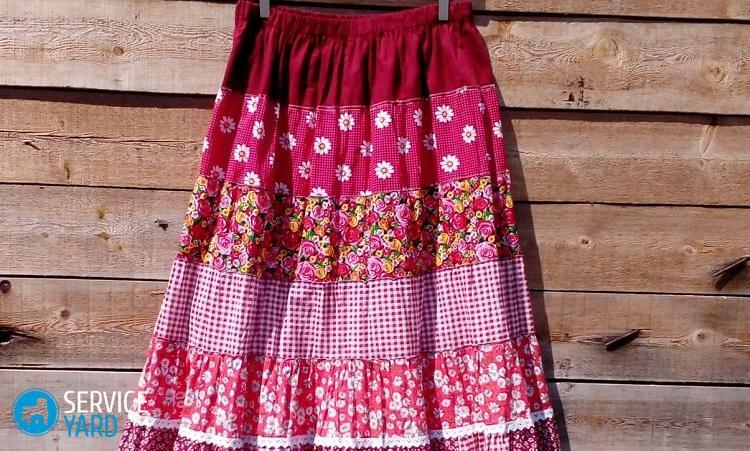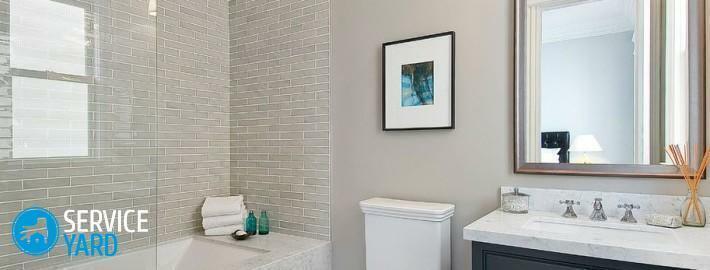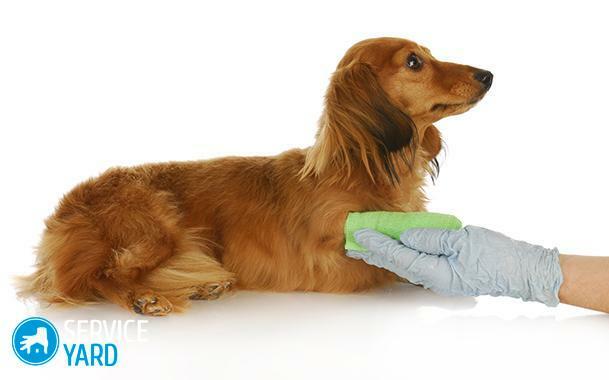
- Some information about the multi-tier model
- We sew a multi-tiered skirt
- Moderate width model
- Model with thick and fluffy frills
- Model of the product with separate rows
- Lush model of chiffon
The multi-tiered skirts have always been fashionable and stylish wardrobe items. In summer this practical and light clothing is one of the most favorite among many women. In addition, this beautiful skirt can be safely dressed anywhere: on the beach, walk, party or when going to the store. If you still do not have such a thing in the wardrobe, then we'll tell you how to sew a multi-tiered skirt. Moreover, the modeling and tailoring are quite simple.
to the contents ↑Some information about the multi-tier model
First of all, this garment has a number of advantages:
- The skirt is incredibly practical.
- Its very comfortable to wear.
- Light and airy style.
- Has a beautiful appearance.
- Does not restrict movement.
- Visually increases growth.
A multi-tiered skirt with their own hands can differ by:
- The number of tiers. You choose the number of rows you need to your taste.
- Their width and height. Tiers can have the same height or differ from each other.
- The amount of assemblies. Lush and less thick frills at the skirt.
- Used fabric. Also choose to your taste, it can be satin, chiffon, linen, guipure, tulle. For a larger volume, it is optimal to use more rigid fabrics, for example, taffeta or kapron.
Important! Before tailoring, think about the style of the product. For women with a slim figure there are no restrictions on the cut of clothes, and ladies with more magnificent forms should avoid unnecessarily voluminous and magnificent assemblies.
to the contents ↑Sewing a multi-tiered skirt
How to sew a multi-tiered skirt into the floor? To do this, you do not need special skills and sewing education, as the pattern is rectangles of fabric, excellent in width and length.
And here are some useful tips that will help simplify the creation process:
- The assembly is best done from the bottom rows to the top.
- Each strip of fabric is sewn into a ring.
- Mark the middle of all the details with a contrasting thread. This will help in the future evenly distribute the folds relative to the mark, and also connect the centers of the upper and lower tiers.
- A qualitative assembly can be obtained by making two parallel lines along the edge of the tier, and then pulling the fabric behind two strands.
- Rows of light fabric can be spliced. As a result, you will receive a small decorative ruchet along the seam. The main thing is to process the edges beforehand, which can be supplemented with original braid or a delicate lace.
- The layers of dense material are fixed with a stitch seam. The upper edge with frills of one row is connected to the bottom of the next one. The material is placed face to face. Sweep away the details and sew from the wrong side on the sewing machine.
Moderate width model
Consider how to sew a multi-tiered skirt step-by-step. The length of our product will be 75 cm, and the number of rows will be three. In this case, the style will not be too lush.
Calculation of material and patterns
First, calculate the width of each row. In our model, the tiers differ in width by 4 centimeters from each other. We calculate:
- From the length of the product we subtract the difference multiplied by the number of tiers: 75 -( 4 cm * 3 rows).The result is 63 cm, which is again divided by the number of rows at the skirt - 3.
- The resulting digit is 21 centimeters and is the width of the first level.
- To it we add 4 cm. We get 25 centimeters - this is the width of the second row.
- Again add 4 cm, and get 29 centimeters - this is the width of the third tier.
The next step is to calculate the length of each level.
Important! To do this, we need an additional value - the assembly factor, which is in the range from 1.1 to 3. That is, 1.1 - is a weak and hardly noticeable folds, and 3 - a dense and magnificent assembly on a skirt.
As the shape of our product assumes an average width, then the assembly factor will be equal to two.
We make the calculation:
- The highest level is equal to the girth of the hips with an addition to this figure of 5-7 cm. Let's say the girth is 90, in the end - the length of the first row will be equal to - 97 centimeters.
- The second tier is equal to the product of the length of the first tier and the assembly factor, i.e.97 * 2 = 194 cm
- The third tier is calculated in the same way: 194 * 2 = 388 centimeters.

Tailoring
After the calculations, the longline skirt with its own hands is sewn according to the following pattern:
- Cut the rectangles of the required sizes
Important! When cutting the details of the product, add 1 cm to the allowances.
- Sew them into rings.
- We form the folds.
- We connect tiers with each other.
- At the top insert the rubber band.
- We work on the hem of the skirt.
Model with thick and fluffy frills
Now consider how to sew a multi-tiered skirt into the floor of a wider style. For this example, let's take the length of the article equal to 96 cm, and let the layers be 4.
Calculation of the material and patterns of
Begin the calculations with the width of each level. For this model, let the difference in the width of the line be 2 cm. We calculate the calculation:
- Determine the width of the upper row, for which the length of the product is subtracted from the difference of each tier: 96 cm -( 2 + 2 * 2 cm + 3 * 2 cm) = 84centimeter. And divide the result by the number of rows - 4.
- The value obtained is 21, and is the width of the first tier.
- The second row is larger than the previous one by 2 centimeters: 21 + 2 = 23 cm.
- The third one is calculated by analogy and we get 25 cm.
- The fourth one is equal to 27 centimeters.
The next step is to calculate the length of each level. To do this, we again need the build factor, which will be equal to 1.7.We make the calculations:
- The length of the first row is equal to the girth of the hips with the addition of 7 cm. That is, again 97 cm.
- Second level: 97 * 1,7 = 165 cm.
- Third row: 165 * 1,7 = 280 cm.
- And the last one: 280 * 1,7 = 476 cm.
After that, the skirt is made similar to the previous model.
According to this sewing method, you are already able to figure out how to sew a multi-tiered skirt for a girl. The main thing is to determine the number of levels, length and width of the product.
to content ↑Model of product with separate rows
The feature of this product is that the layers are not connected to each other, but are attached to the base. The basis is most often a pattern of a straight or conical skirt.
Important! Tiers must be joined in such a way that the lower edge of one level overlaps the upper edge of the next, then the seams will not be visible.
The longline skirt with its own hands from three separate levels is sewn as follows:
- Cut out and sew the skirt under the frills.
- On it, indicate the location of the tiers, thus you have determined the width of each row. Draw a line and label each level with letters A, B, B.
- From lines A and B, move upwards 4 cm and draw the dotted lines - these will be the points of joining the lines.
- The length of each row is determined in the same manner as above.
Lush model of chiffon
Separately tell how to sew a multi-tiered skirt into the floor of a material such as chopped chiffon. The advantages of this fabric are:
- Lightness and airiness.
- No need to iron the skirt.
- The fabric is softer in the vertical direction, which makes the figure thinner.
Calculation pattern
The model will have 4 levels, and is calculated for the hip circumference 100 cm
The width of the upper row will be 18 cm, and the next three - 27 cm
The length of the levels will be as follows:
- The first and the topmost are 150 cm. The
- The second is 150 cm.
- The third is 300 cm.
- Fourth - 600 cm.

. Sewing the parts.
. Cutting the parts and proceeding to the connection:
- . The seams can be connected directly with the help of an overlock.
- After that, work on the overlock each row around the perimeter.
- Attach the rubber band to the upper tier. This can be done on a sewing machine: a thin rubber band is wound on a bobbin, and put the standard thread on top. Attach the elastic band at a distance of 1-1.5 cm from the edge.
Important! The first tier will look more effective, if you attach the elastic by its entire width to this method. The stitches should go parallel to each other at a distance of 1 cm
- Collect all the layers overlapping, thus forming elegant ruffs about 1 cm wide at the junction points. You can make them wider - it all depends on your preferences.
Important! Do not worry that the lower tier is so long. Chiffon is a very light fabric, and the assembly will look lush and beautiful, but not massive.
A multi-tiered skirt with your own hands will decorate your wardrobe. You do not want to wear any other products of a different style, preferring such a beautiful piece of clothing. And your appearance will be truly feminine and beautiful.



